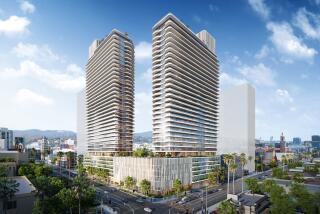The call for small
JONATHAN ZEPP is the rare Hollywood executive who gets to walk to work in the morning.
Zepp, executive director of business and legal affairs at Paramount Pictures’ Digital Entertainment division, and his wife, Lucy, an account supervisor for a PR agency, closed on their condominium in a new 10-unit project on North Bronson Avenue in July. They were drawn not only by its proximity to the Paramount Pictures lot on Melrose Avenue but also by its open design and the intimacy offered by a smaller development.
The Zepps, both 30, are among a group of buyers whose first-home purchase is in the increasing stock of small condominium projects, mostly new developments taking the place of older duplexes or single-family homes cropping up in dense urban neighborhoods.
Much of the activity is taking place in Hollywood and West Hollywood, though projects are being built in Culver City, Venice, Century City and other pockets throughout the region. And although units in these smaller condo projects are generally priced higher on a per-square-foot basis than those in apartment-style buildings, the appeal for many first-time home buyers is the ability to buy into a new, more intimate urban development as well as the lower homeowners association dues.
There are no hard data on how rapidly the number of small condo complexes has grown -- firms that track the real estate market generally cut off their research at 10 or 20 units. But there is some evidence of the growing trend. For example, Vigen Onany & Associates Inc., a La Crescenta real estate consulting firm that has put together budgets for homeowners associations at hundreds of condominium projects, claims to handle roughly 50% of that market and has done budgets for more than 1,200 small projects since 2000. That year, the firm said, it put together association budgets for 160 developments of 10 units or fewer in Southern California. Last year, that number reached 650, up from 400 a year earlier. It has since backed off to just 350 projects so far this year.
Although buyers cite location, design and lower monthly costs as primary factors in choosing smaller condo developments over single-family homes or units in high-rises, as entry-level housing goes, many of these projects are pricey. Yet enough buyers are willing to pay the higher initial cost for visually interesting designs to support this market.
“People don’t want cookie-cutter,” said Richard Papalian, president of Papalian Capital Partners in Pacific Palisades, which is developing projects of four, 10 and 12 units in the Miracle Mile and West Hollywood.
“When you start to have a large open space and contemporary feel, it’s more expensive to build,” he said. “It’s not, ‘How many bedrooms and baths can I cram into so many square feet?’ ”
The Zepps paid “in the mid- to high-$800,000” range, roughly $460 per square foot, for their 1,850-square-foot unit in the building developed by Hollywood-based Urban Environments.
By comparison, DataQuick Information Services, which tracks residential real estate trends, reported a median price per square foot of $367 for a condo in Los Angeles County in October. There is no independent tracking of sales in projects of 10 units and fewer.
One offset to the higher per-square-foot price can be lower homeowners association dues. Because smaller projects generally don’t have pools, gyms or full-time front-desk or maintenance staff, monthly dues to cover taxes, insurance, water and gardening bills can be one-third of those at a larger complex.
“One appeal is dues of $150 a month,” said Tony Myers, an agent at Re/Max All Cities-Brentwood, who has sold condos in small developments. “Some people like to keep the . . . dues low and have special assessments” when a capital expenditure is needed, he said.
‘Compatible personalities’
Like larger condo projects, smaller developments are governed by a set of covenants, conditions and restrictions that define how monthly dues are applied. The homeowners association is also responsible for levying special assessments for large capital expenditures, and conflicts can arise among neighbors over their application. In a project of half a dozen or fewer units, those issues could be magnified.
Michael Papale, a vice president of sales and business development at Exponential Interactive, bought one of four units in a Venice complex as his primary residence and owns another condo in a 20-unit building run by a property management firm. The owners in the smaller property have a greater say in how things are handled, he said. “It gives us more decision-making power.”
The potential for conflict with neighbors was something Zepp, a lawyer, took into consideration when he and his wife started looking at smaller projects.
“We decided that this was so unique in design and layout that it attracted a certain kind of people,” he said, “that there would probably be a lot of compatible personalities.”
Indeed, having like-minded neighbors was just one of the factors the Zepps looked at as part of the decision to make their first home purchase in an urban, 10-unit complex with poured-concrete floors and 19-foot ceilings.
The overwhelming majority of buyers are young professionals, both couples and individuals, developers say. Although a handful of empty-nesters have bought into them, the complexes are unlikely to appeal to families with young children.
“Usually, the buyer is 25 to 40 years old, mostly single with no children,” said Lydia Simon, an agent with Coldwell Banker Westside and Malibu who deals exclusively in condo sales.
The appeal, she said, goes beyond the ability to buy a town-home-style project in an urban environment for less than the cost of a comparably sized single-family home.
“People like being part of a new project,” she said. These projects, most newly built, come with new appliances, a one-year builder’s warranty and, often, a design that has more open space and is flexible enough to cater to individual tastes.
“Buyers are looking for something where they can express themselves, to put their personality onto the projects,” said Lawrence Scarpa, a principal at Pugh + Scarpa Architects in Santa Monica. In designing smaller complexes, his firm attempts to create as flexible a space as possible. “We treat it as large a light-filled [space] as possible, sparse and neutral so someone can come in and envision what they think the space ought to be.”
Live-work concept
That was part of the appeal for Nick Stabile, a 37-year-old actor and producer who last year bought a 1,300-square-foot live/work condo on North Highland Avenue for just under $1 million. The property was developed by L.A.-based Universal Live Work, which is now in construction on two similar projects a few blocks east on Larchmont Boulevard.
Stabile uses the unit, one of four in the building, primarily as a home for his Bella Vita Entertainment production company. When he and his wife work late, they opt to spend the night at the Hollywood condo rather than head back to their Malibu home.
“We chose it because of the unique setup -- work-live,” he said. “Downstairs is work, just a really nice, comfortable environment with big windows and lots of light. It doesn’t feel like an office.”
For Zepp, a New York transplant who rented an apartment near 3rd Street and Fairfax Avenue for three years before buying, the home on North Bronson Avenue should salve any lingering longing for the East Coast, where he also walked to work.
“Just like old times,” he said.
More to Read
Sign up for Essential California
The most important California stories and recommendations in your inbox every morning.
You may occasionally receive promotional content from the Los Angeles Times.










